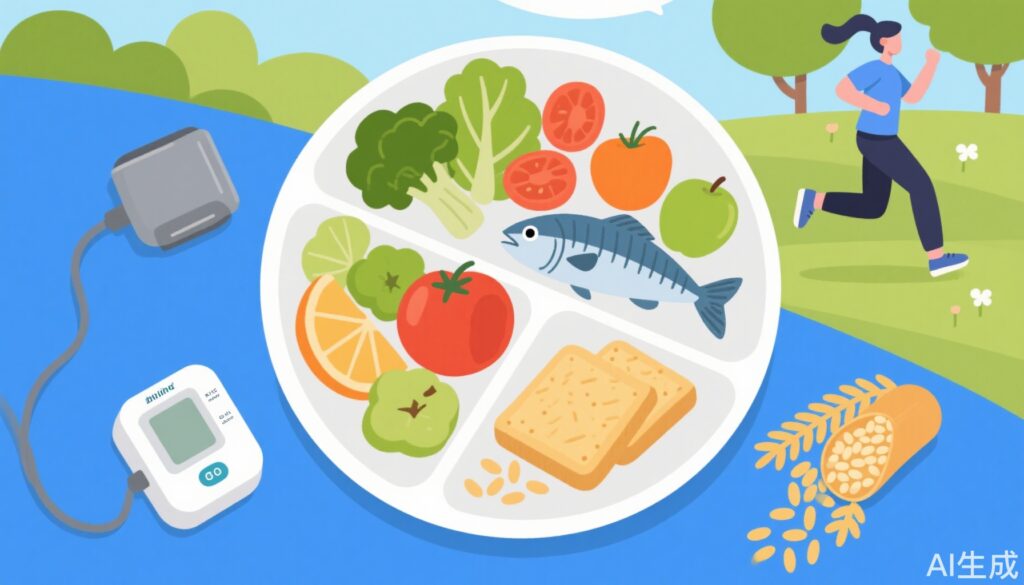Introduction to Hypertension and Its Risks
Hypertension, or high blood pressure, is one of the leading causes of cardiovascular diseases such as coronary heart disease and stroke, which contribute significantly to mortality worldwide. Statistics show that approximately one in four adults has hypertension. The prevalence increases with age: 13.3% among adults aged 18-44, 37.8% among those 45-59, and 59.2% in people aged 60 and above.
Dietary Factors Associated with Hypertension
Many risk factors for hypertension are linked to unhealthy dietary habits. These include excessive sodium intake, insufficient potassium intake, and excessive alcohol consumption. Such dietary patterns contribute to elevated blood pressure and increase the risk of cardiovascular complications.
How Can Hypertensive Patients Manage Their Diet?
Reduce Sodium and Increase Potassium Intake
A crucial step is to gradually reduce daily salt consumption to less than 5 grams per day. Patients should increase intake of potassium-rich foods such as fresh vegetables, fruits, and legumes. A diet that is light and less salty is recommended.
Choose Nutrient-Rich Foods
Selecting foods rich in calcium and magnesium supports blood pressure control. At the same time, it is advisable to limit foods high in saturated fat and cholesterol, including fried foods, animal organs, butter, and processed red meats like bacon, sausages, and cured meats.
Opt for Healthy Fats
Plant-based oils such as olive oil and canola oil are preferred over animal fats like lard or beef tallow. Incorporating moderate amounts of omega-3 fatty acid-rich foods, such as deep-sea fish including salmon and mackerel, can provide cardiovascular benefits.
Adopt a Balanced and Scientific Dietary Pattern
Hypertensive individuals should follow a well-rounded diet with varied food groups and regular meals. It is recommended to consume more fiber-rich fruits and vegetables, ensuring that dark green vegetables make up at least half of total vegetable intake. Note that fruits should complement, not replace, vegetables.
A moderate intake of grains and tubers is advised, with whole grains or mixed beans comprising 25% to 50% of grain intake. Protein should be obtained from dairy products, fish, soybeans, and related products. Limiting added sugars is also important.
Example Seasonal Diet for Northwest China in Spring
A sample diet for this region and season would emphasize fresh local vegetables, fruits, whole grains, legumes, and fish, prepared with minimal salt and healthy cooking methods such as steaming or stir-frying with plant oils.
Maintain Energy Balance and Healthy Weight
Maintaining a healthy weight is critical for blood pressure control. The recommended body mass index (BMI) is between 18.5 and 23.9. Waist circumference targets are less than 85 cm for men and less than 80 cm for women.
Patients who are overweight or obese should aim to lose weight by reducing energy intake by 300 to 750 kilocalories daily and increasing physical activity. Regular moderate-intensity aerobic exercise is encouraged, with a goal of 2.5 to 5 hours per week, or 1.25 to 2.5 hours of vigorous activity. Reducing sedentary time is also important.
Smoking Cessation, Alcohol Moderation, and Psychological Well-being
Hypertensive patients are strongly advised to quit smoking and avoid passive smoke exposure. Alcohol consumption should be limited or avoided altogether.
Managing stress is essential, as mental tension activates the sympathetic nervous system, raising blood pressure. Patients should engage in stress management techniques and maintain psychological balance. A regular sleep schedule with adequate rest and avoidance of late nights supports blood pressure stability.
Blood Pressure Monitoring and Self-management
Regular monitoring of blood pressure helps patients understand their levels and treatment goals. Following medical advice regarding lifestyle interventions and adhering to long-term treatment plans are essential for effective control.
Patients should have follow-up appointments based on their overall cardiovascular risk and blood pressure status to ensure timely adjustments in therapy.
Conclusion
Effective hypertension management involves a comprehensive approach that includes dietary modifications, physical activity, weight management, smoking cessation, alcohol moderation, psychological well-being, and consistent self-monitoring. Adopting these lifestyle changes can significantly reduce the risk of cardiovascular disease and improve overall health outcomes for individuals living with hypertension.



